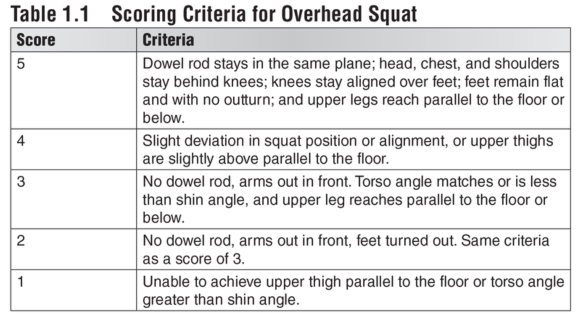The Movement Screen Test Part I ' Overhead Squat
This is an excerpt from Complete Conditioning for Volleyball by Steve Oldenburg.
Movement Screen
The movement screen is composed of 10 tests. Seven tests - overhead squat, single-leg squat, ankle dorsiflexion, stability push-up, prone scarecrow, internal shoulder rotation, and landing competency - are scored on a 5-point scale in which 5 is excellent and 1 is poor. The posture assessment, scapular dyskinesis test, and Ober's test are qualitative tests that are not scored but are critical for understanding the overall scope of the athlete's physical state. On completion of the movement screen, test scores are recorded and graphed to give athletes and coaches visual feedback of the overall results and areas needing improvement and to identify athletes who have a higher risk of injury.
Overhead Squat
Purpose
To assess total-body mobility and stability in a bilateral stance
Setup
The athlete performs the test while barefoot. The athlete's toes are on a line, feet straight forward with the insteps of both feet in vertical alignment with the outsides of the shoulders. The athlete holds a dowel rod overhead so that the upper and lower arms are at 90-degree angles.
Procedure
- The athlete presses the dowel rod maximally overhead.
- Keeping the dowel rod in the same plane, the athlete slowly descends into the deepest squat possible (figure 1.2).
- The athlete holds for 3 seconds at the bottom of the squat and returns to the starting position.
- The athlete is given a maximum of three attempts.
- If a score of 4 or 5 is not achieved (see table 1.1 for scoring criteria), the athlete repeats the test without the dowel rod, but with elbows extended and shoulders flexed at 90 degrees so the arms are parallel to the floor.
- If a score of 3 is not achieved, the athlete repeats the test without the dowel rod, but with elbows extended and shoulders flexed at 90 degrees so the arms are parallel to the floor. The athlete's feet are rotated out 15 degrees with the insides of the heels in vertical alignment with the outsides of the shoulders.

Overhead squat.
Assessment

SHOP

Get the latest insights with regular newsletters, plus periodic product information and special insider offers.
JOIN NOW
Latest Posts
- Assessment of the Atlanto-Axial Joint (AAJ)
- Side-bending Muscle Energy Technique (MET) for the cervical spine
- Ligaments of the vertebral column in the cervical spine
- What are exercise snacks?
- Create positive muscle-strengthening experiences for those with excess weight
- Empower health behavior change through effective communication and motivational interviewing


